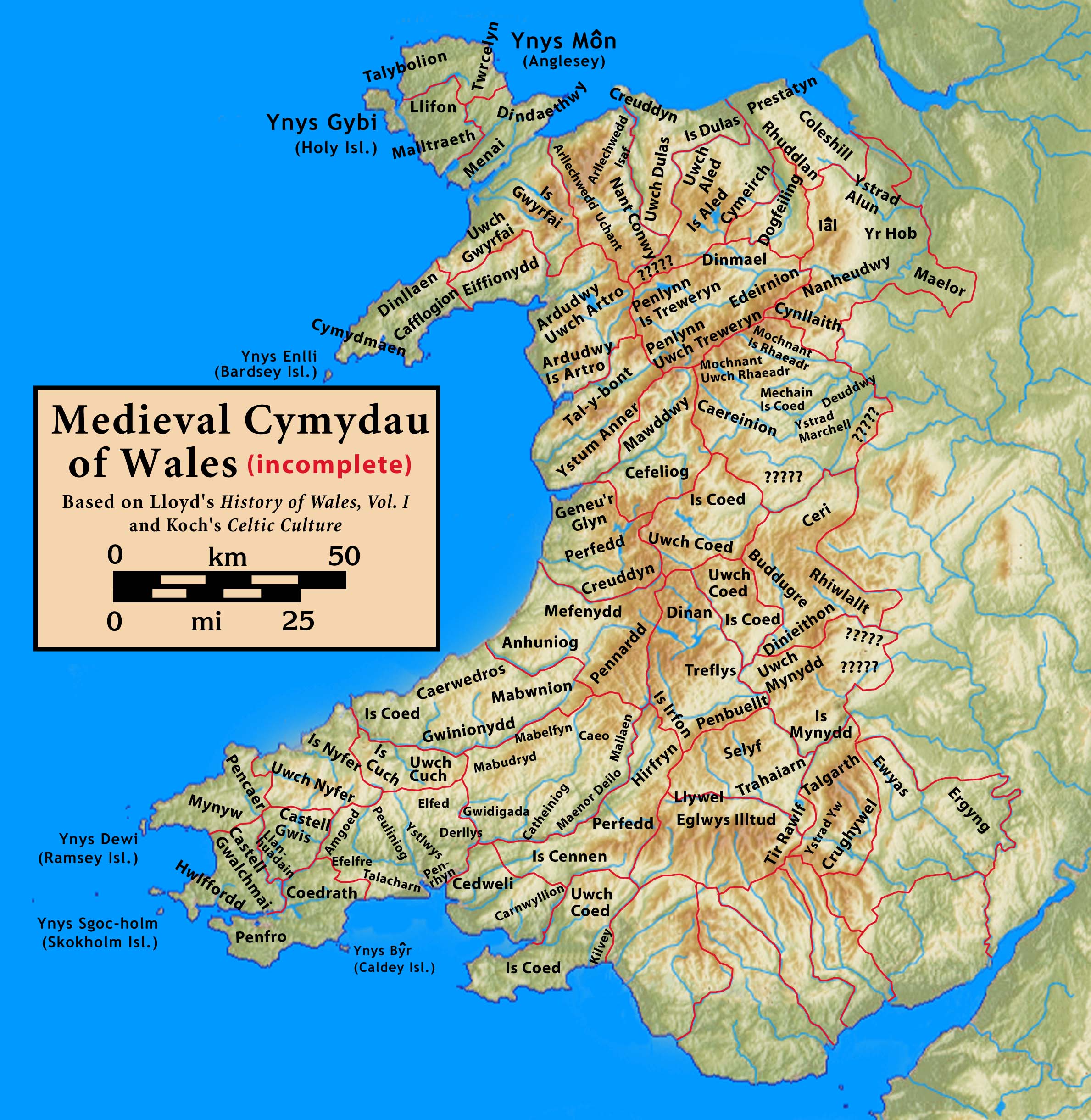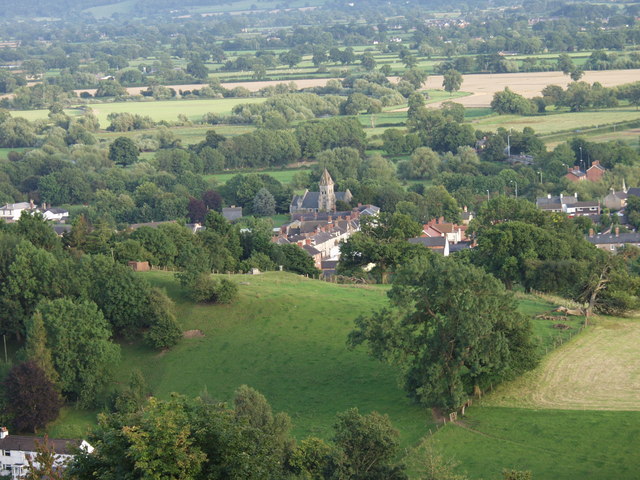|
Mochnant Is Rhaeadr
was a medieval cantref in the Kingdom of Powys. In the 12th century it was divided into the commotes of Mochnant Is Rhaeadr (in the north) and Mochnant Uwch Rhaeadr (in the south) (''Is'' signifying 'below' and ''Uwch'' 'above' the River Rhaeadr). Its north-west border was with the cantref of Penllyn, originally in Powys but which became annexed to the Kingdom of Gwynedd during the time of Owain Brogyntyn. It bordered the cantrefi of Caereinion and Mechain to the south, and Maelor to the north-east. The administrative centre was Llanrhaeadr-ym-Mochnant in Mochnant Is Rhaeadr. After the death of Madog ap Maredudd and his eldest son and heir in 1160, the kingdom was divided up between his surviving sons Gruffydd Maelor, Owain Fychan and Owain Brogyntyn, his nephew Owain Cyfeiliog and his half-brother Iorwerth Goch. Mochnant was initially given to Iorwerth Goch, but in 1166 he was ejected by Owain Cyfeiliog and Owain Fychan, who took control of Mochnant Uwch Rhaedr and Mochnant I ... [...More Info...] [...Related Items...] OR: [Wikipedia] [Google] [Baidu] |
Wales
Wales ( ) is a Countries of the United Kingdom, country that is part of the United Kingdom. It is bordered by the Irish Sea to the north and west, England to the England–Wales border, east, the Bristol Channel to the south, and the Celtic Sea to the south-west. , it had a population of 3.2 million. It has a total area of and over of Coastline of Wales, coastline. It is largely mountainous with its higher peaks in the north and central areas, including Snowdon (), its highest summit. The country lies within the Temperate climate, north temperate zone and has a changeable, Oceanic climate, maritime climate. Its capital and largest city is Cardiff. A distinct Culture of Wales, Welsh culture emerged among the Celtic Britons after the End of Roman rule in Britain, Roman withdrawal from Britain in the 5th century, and Wales was briefly united under Gruffudd ap Llywelyn in 1055. After over 200 years of war, the Conquest of Wales by Edward I, conquest of Wales by King Edward I o ... [...More Info...] [...Related Items...] OR: [Wikipedia] [Google] [Baidu] |
Owain Fychan
Owain Fychan ap Madog (alternatively ''Owain Vychan ap Madoc''; c. 1125 – 1187) was styled Lord of Mechain, Mechain Is Coed and one of the sons of Madog ap Maredudd. His mother was Susanna, daughter of Gruffudd ap Cynan. Division of the Kingdom of Powys His eldest brother, Llywelyn, was killed soon after the death of his father in 1160, at which point Powys was shared between Madog's sons Gruffydd Maelor, Owain Fychan and Owain Brogyntyn, his nephew Owain Cyfeiliog and half-brother Iorwerth Goch ap Maredudd, Iorwerth Goch. Owain Fychan shared the southern portion of his father's territories with Owain Cyfeiliog. Working together they drove the English out of Carreghofa in 1163 (capturing and destroying the royal castle there, which was made of timber until fortified in stone in 1194) and Iorwerth Goch from Mochnant, Mochnant Is Rhaeadr in 1166. Owain Fychan now controlled Mechain, Cynllaith, Caereinion and Mochnant Is Rhaeadr. Carreghofa Castle was retaken by Henry II of Engl ... [...More Info...] [...Related Items...] OR: [Wikipedia] [Google] [Baidu] |
Rocky Hillside Of The Afon Rhaeadr Valley - Geograph
''Rocky'' is a 1976 American independent sports drama film directed by John G. Avildsen and written by and starring Sylvester Stallone. It is the first installment in the ''Rocky'' franchise and also stars Talia Shire, Burt Young, Carl Weathers, and Burgess Meredith. In the film, Rocky Balboa (Stallone), a poor small-time club fighter and loanshark debt collector from Philadelphia, gets an unlikely shot at the world heavyweight championship held by Apollo Creed (Weathers). ''Rocky'' entered development in March 1975, after Stallone wrote the screenplay in three days. It entered a complicated production process after Stallone refused to allow the film to be made without him in the lead role; United Artists eventually agreed to cast Stallone after he rejected a six figure deal for the film rights. Principal photography began in January 1976, with filming primarily held in Philadelphia; several locations featured in the film, such as the Rocky Steps, are now considered cultural l ... [...More Info...] [...Related Items...] OR: [Wikipedia] [Google] [Baidu] |
Marcher Lord
A marcher lord () was a noble appointed by the king of England to guard the border (known as the Welsh Marches) between England and Wales. A marcher lord was the English equivalent of a margrave (in the Holy Roman Empire) or a marquis (in France) before the introduction of the title of "marquess" in Britain; no marcher lord ever bore the rank of marquess. In this context, the word ''march'' means a border region or frontier, and is cognate with the verb "to march", both ultimately derived from Proto-Indo-European ''*mereg-'', "edge" or "boundary". The greatest marcher lords included the earls of Chester, Gloucester, Hereford, Pembroke and Shrewsbury (see also English earls of March). County palatine Some strong earldoms along the Welsh border were granted the privileged status of county palatine shortly after the Norman Conquest, but only that based on Chester survived for a long period. The term particularly applies to Anglo-Norman lords in Wales, who had complete ... [...More Info...] [...Related Items...] OR: [Wikipedia] [Google] [Baidu] |
Conquest Of Wales By Edward I
The conquest of Wales by Edward I took place between 1277 and 1283. It is sometimes referred to as the Edwardian conquest of Wales,Examples of historians using the term include Professor J. E. Lloyd, regarded as the founder of the modern academic study of Welsh history, in his ''History of Wales from the Earliest Times to the Edwardian Conquest'', first published in 1911, and Professor R. R. Davies, the leading modern scholar of the period, in his works including ''The Age of Conquest: Wales, 1063–1415'', published 2000. to distinguish it from the earlier (but partial) Norman conquest of Wales. In two campaigns, in 1277 and 1282–83, respectively, Edward I of England first greatly reduced the territory of Llywelyn ap Gruffudd ("Llywelyn the Last"), and then completely overran it, as well as the other remaining Welsh principalities. By the 13th century, Wales was divided between native Welsh principalities and the territories of the Anglo-Norman Marcher lords. The leading ... [...More Info...] [...Related Items...] OR: [Wikipedia] [Google] [Baidu] |
Edward I Of England
Edward I (17/18 June 1239 – 7 July 1307), also known as Edward Longshanks and the Hammer of the Scots (Latin: Malleus Scotorum), was King of England from 1272 to 1307. Concurrently, he was Lord of Ireland, and from 1254 to 1306 ruled Duchy of Gascony, Gascony as Duke of Aquitaine in his capacity as a vassal of the French king. Before his accession to the throne, he was commonly referred to as the Lord Edward. The eldest son of Henry III of England, Henry III, Edward was involved from an early age in the political intrigues of his father's reign. In 1259, he briefly sided with a baronial reform movement, supporting the Provisions of Oxford. After reconciling with his father, he remained loyal throughout the subsequent armed conflict, known as the Second Barons' War. After the Battle of Lewes, Edward was held hostage by the rebellious barons, but escaped after a few months and defeated the baronial leader Simon de Montfort at the Battle of Evesham in 1 ... [...More Info...] [...Related Items...] OR: [Wikipedia] [Google] [Baidu] |
Powys Wenwynwyn
Powys Wenwynwyn or Powys Cyfeiliog was a Welsh kingdom which existed during the high Middle Ages. The realm was the southern portion of the former princely state of Kingdom of Powys, Powys which split following the death of Madog ap Maredudd of Powys in 1160: the northern portion (Maelor) went to Gruffydd Maelor and eventually became known as Powys Fadog; while the southern portion (Cyfeiliog) going to Owain Cyfeiliog and becoming known, eventually, as Powys Wenwynwyn after Prince Gwenwynwyn ab Owain, its second ruler. Powys Wenwynwyn and Kingdom of Gwynedd, Gwynedd became bitter rivals in the years that followed, with the former frequently allying itself with England to further its aims of weakening the latter. Princes of Powys Wenwynwyn * 1160–1195 Owain Cyfeiliog married a daughter of Owain Gwynedd and abdicated in 1195. * 1195–1216 Gwenwynwyn ab Owain Gwenwynwyn seized the cantref of Arwystli in 1197, when he was aligned with England. Following the marriage of Llywely ... [...More Info...] [...Related Items...] OR: [Wikipedia] [Google] [Baidu] |
Powys Fadog
Powys Fadog (English: ''Lower Powys'' or literally ''Madog's Powys'') was the northern portion of the former princely realm of Powys. The princes of Powys Fadog would build their royal seat at Castell Dinas Brân, and their religious center at Valle Crucis Abbey. Some of its lordships included those of Maelor, Mochnant, Glyndyfrdwy, Yale, and Bromfield and Yale. Following the division of Powys, their cousin branch, the princes of Powys Wenwynwyn, would build Powis Castle. The principality's first prince was Gruffydd Maelor I, and its last sovereign prince was Madog II ap Gruffydd, following the Conquest of Wales by king Edward Longshanks. History Powys Fadog split in two in 1160 following the death of Prince Madog ap Maredudd. He was a member of the Royal House of Mathrafal, founded by grandfather, King Bleddyn ap Cynfyn, who led a defence with the Anglo-Saxons against William the Conqueror.Pierce, T. J., (1959)MADOG ap MAREDUDD (died 1160), king of Powys Dictiona ... [...More Info...] [...Related Items...] OR: [Wikipedia] [Google] [Baidu] |
Chirk
Chirk () is a town and Community (Wales), community in Wrexham County Borough, Wales, south of Wrexham, between it and Oswestry. At the 2011 census, it had a population of 4,468. Historically in the historic counties of Wales, traditional county of Denbighshire (historic), Denbighshire, and later Clwyd, it has been part of Wrexham County Borough since a local government reorganisation in 1996. The Wales-England border, border with the England, English county of Shropshire is immediately south of the town, on the other side of the River Ceiriog. The town is served by Chirk railway station and the A5 road (Great Britain), A5/A483 road, A483 roads. Etymology The name of the town in English, Chirk, derives from the name of the River Ceiriog, which itself may mean "the favoured one". The Welsh place name, ', is literally "The Moor". History and heritage Chirk Castle, a National Trust for Places of Historic Interest or Natural Beauty, National Trust property, is a medieval castle. ... [...More Info...] [...Related Items...] OR: [Wikipedia] [Google] [Baidu] |
Ceiriog Valley
The Ceiriog Valley () is the valley of the River Ceiriog in north-east Wales. Its Welsh name, "Dyffryn Ceiriog", is the name of an electoral ward of Wrexham County Borough. The ward is the largest ward of the county borough by area and forms a strikingly-shaped salient of the county borough between Powys and Denbighshire. Geography The valley forms part of the traditional county of Denbighshire, and between 1974 and 1996 was part of the short-lived county of Clwyd. Part of the lower end of the valley extends into Shropshire, England. The Ceiriog Valley is long and runs generally west to east, south of the Vale of Llangollen. It is something of a dead end, with the B4500 road terminating at Llanarmon Dyffryn Ceiriog, a village near the head of the valley. The -long, -gauge Glyn Valley Tramway used to run through some of the valley; it served various quarries and provided a passenger service between Chirk and Glyn Ceiriog. The valley receives relatively few visitors, despite ... [...More Info...] [...Related Items...] OR: [Wikipedia] [Google] [Baidu] |
Iorwerth Goch Ap Maredudd
Iorwerth Goch ap Maredudd (c. 1110 – c. 1171), a minor prince and nobleman of the Kingdom of Powys, was the illegitimate son of Maredudd ap Bleddyn and Cristin ferch Bledrus. The appellation "Goch", meaning red, probably referred to the colour of his hair. Iorwerth married Maud de Manly, who gave him two sons, Gruffydd Fychan (c. 1150), and Hywel ap Iorwerth He had one brother, Hywel ap Maredudd, and two half-brothers, Madog ap Maredudd and Gruffydd ap Maredudd. Iorwerth is known to have taken Tomen y Rhodwydd (castle of Yale) in 1157, situated in Llandegla, Denbighshire, Wales. The castle was initially built by Owain Gwynedd in 1149, and was burnt down by Iorwerth. ''The Dream of Rhonabwy'' in the ''Mabinogion The ''Mabinogion'' () is a collection of the earliest Welsh prose stories, compiled in Middle Welsh in the 12th–13th centuries from earlier oral traditions. There are two main source manuscripts, created –1410, as well as a few earlier frag ...'' mentions Iorw ... [...More Info...] [...Related Items...] OR: [Wikipedia] [Google] [Baidu] |






